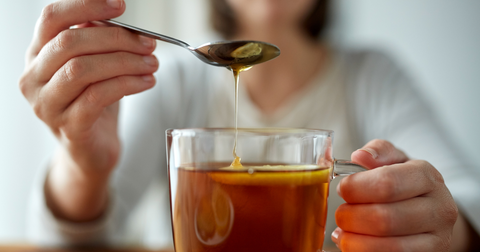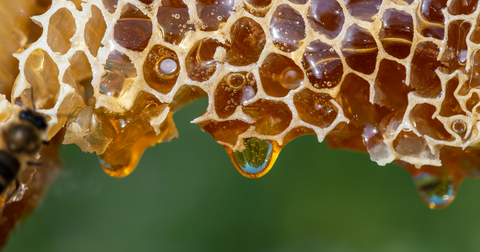
Honey is a natural sweetener, valued for its health benefits and rich flavour. However, with so many brands and types of Honey available in the market, it's essential to ensure the product you're buying is natural, 100% pure and not adulterated with additives or artificial sweeteners.
In this blog, we'll walk you through simple methods to perform a Honey purity test at home, how to check the colour of the original Honey, and, most importantly, how to tell if Honey is real or fake. These easy tests will give you confidence in choosing only the best, pure Honey for yourself and your family.
How Can You Tell If Honey is Real or Fake?
One of the biggest challenges consumers face is distinguishing between real and fake Honey. Unfortunately, some commercial Honey products are mixed with sugar syrups or other fillers to cut costs. But how can you tell if Honey is real or fake? Here are some quick and effective ways to check:
#1 Label Examination:
Before even testing at home, start with the label. Look for words like "100% pure" or "Raw Honey."
Avoid products that list added sugar, high fructose corn syrup, or other artificial ingredients. A shorter, more transparent ingredients list is usually a good sign.
Here is a Honey Label where you can get all this information, so you are sure before buying.

#2 Consistency and Texture:
Real Honey is naturally thick and viscous. It flows slowly when poured. If your Honey runs quickly, like water, or has a very thin consistency, it could be a sign that it has been diluted with liquids like sugar syrup or water.
#3 Taste and Aroma:
Genuine Honey has a complex, rich flavour that varies depending on its floral source, with subtle undertones that come from the plants and flowers the bees collect the nectar from.
Fake Honey often has a very sweet, almost sugary taste without any depth or distinct floral aroma.
Testing for Honey purity isn’t just about the product itself but also your experience of it — how it looks, tastes, and feels can reveal a lot about its quality.
How to Check Pure Honey in Water
One of the most popular methods for checking Honey purity at home is the water test. This test requires minimal effort and materials, yet it effectively reveals if your Honey has been adulterated. Here's how to do it:
#Step 1: Fill a glass with clean water.
#Step 2: Take a spoonful of Honey and drop it gently into the water.
What Should You Look For?
If the Honey sinks to the bottom of the glass and remains solid, it is likely to be pure. Pure Honey has a higher density and does not mix easily with water. However, if the Honey dissolves quickly or starts spreading in the water, it might contain added sugar syrup or other substances.
The reason this test works is due to the natural composition of Honey. Pure Honey is dense and sticky because of its high sugar content, primarily glucose and fructose. Adulterated Honey, which is often diluted with water or sugar syrup, lacks this density and will mix with water more easily.
Honey Purity Test at Home
Testing the purity of Honey at home is a simple and effective way to ensure you’re consuming a natural, unadulterated product. Besides the water test, there are several other methods you can use to check the purity of Honey, such as the Flame Test, Blot Test, Vinegar Test and Drop Test. Let’s explore each of these tests in detail and see how they help you identify pure Honey.
1. Flame Test
The Flame Test is another interesting way to check whether your Honey is pure or mixed with moisture. This test uses the natural properties of Honey, which makes it combustible in its pure form, while diluted or fake Honey will not ignite.
How Does the Flame Test Work?
Pure Honey is flammable due to its low moisture content. If Honey has been diluted with water or contains moisture, it won’t catch fire.
How to Perform the Flame Test:
#Step 1: Take a dry cotton wick or a matchstick and dip it into the Honey.
#Step 2: Shake off any excess Honey, ensuring the wick is well-coated.
#Step 3: Try to light the wick or matchstick with a lighter.
If the Honey is pure, the wick will ignite and burn steadily. If the Honey is adulterated with water or other additives, the wick will either not catch fire or burn with difficulty, indicating the presence of moisture.
Caution: Be careful while performing this test to avoid any risk of burns or accidents.
2. Blot Test
The Blot Test is a quick and easy way to check for water or liquid adulteration in Honey. By placing Honey on absorbent paper, this test checks how much liquid is present in the Honey.
How Does the Blot Test Work?
Pure Honey is thick and won’t seep through paper easily, while Honey that contains added water will spread and leave a wet stain on absorbent paper.
How to Conduct the Blot Test:
#Step 1: Take a small amount of Honey and place it on a piece of blotting paper or tissue paper.
#Step 2: Wait for a few seconds and observe the behaviour of the Honey.
If the Honey remains in place and doesn’t absorb into the paper, it is likely pure. However, if the Honey is absorbed into the paper and leaves a wet mark, it could indicate that the Honey contains added water.
3. Vinegar Test
The Vinegar Test checks for the presence of adulterants such as chalk powder or other similar substances sometimes added to Honey. This test involves mixing Honey with vinegar and observing the reaction.
How Does the Vinegar Test Work?
When vinegar is added to Honey that has been adulterated with chalk or similar substances, a reaction occurs, causing the mixture to foam or bubble. Pure Honey will not react with vinegar.
How to Perform the Vinegar Test:
#Step 1: Mix a tablespoon of Honey with a small amount of water in a glass.
#Step 2: Add a few drops of vinegar to the mixture and stir gently.
#Step 3: Observe the reaction.
If the mixture begins to foam or produce bubbles, it’s a sign that the Honey has been adulterated with substances like chalk powder. Pure Honey will not produce any reaction with vinegar and will remain unchanged.
4. Drop Test
The Drop Test is a quick way to determine whether the Honey is raw and natural.
How to Perform the Drop Test:
#Step 1: Place a drop of room temperature or cooler Honey on your finger.
#Step 2: Observe how the Honey behaves.
If the Honey spreads quickly and loses its shape, it may be fake. Authentic raw Honey will hold its form and remain a drop on your finger.
Even after all these tests that are done to check the purity of Honey, it may still be fake honey.
Colour of Original Honey

While the texture and taste of Honey are important, the colour of the original Honey is another strong indicator of its purity. The colour of Honey can vary depending on its source and the type of flowers the bees have collected nectar from. Here’s a quick guide to identifying authentic Honey based on its colour:
# Light-Coloured Honey:
Honey sourced from flowers like clover or wildflowers tends to be lighter in colour, often ranging from pale gold to light amber. This Honey usually has a milder, more delicate flavour.
# Dark-Coloured Honey:
Honey made from sources like buckwheat or manuka tends to be much darker, with shades ranging from amber to deep brown. Dark Honey typically has a stronger flavour and is often more nutrient-rich, containing higher levels of antioxidants.
Beware of Honey that is overly pale or watery-looking, as it could indicate adulteration. Real Honey has a natural variation in colour but should always appear vibrant. This variety in colour comes from the plants the bees visited, so it’s entirely natural for different types of Honey to look and taste distinct.
Conclusion: Trust Only the Best Natural Honey
Ensuring your Honey is natural and 100% pure is not only essential for taste but also for your health. By using simple methods like the Honey water test, checking the colour of the original Honey, and knowing how to tell if Honey is real or fake, you can confidently choose Honey that offers all its natural benefits.
At Honey and Spice, we pride ourselves on delivering the highest quality, pure Honey sourced from trusted local farmers and tribal Honey gatherers which make our produce nature's best. Explore our range of Honey products at Honeyandspice.in and experience the authentic taste of real Honey today!






